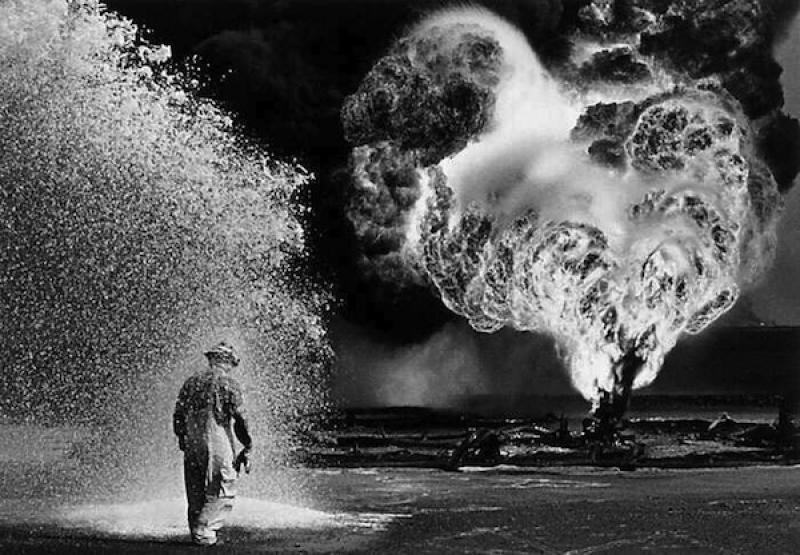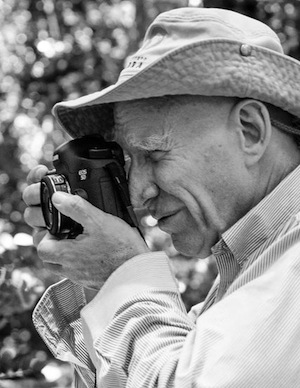The Salt of the Earth | reviews, news & interviews
The Salt of the Earth
The Salt of the Earth
Wim Wenders chronicles the life of a photographer who has visited the heart of darkness

Had Wim Wenders not used the title Until the End of the World for his most ambitious road movie, it would have suited his biographical portrait of Sebastião Salgado. Since 1973, the Brazilian photographer has traversed the planet to document its natural beauty and diversity on one hand, and the greed, destructiveness, and murderous ferocity of man on the other.
Thus, another alternative title for The Salt of the Earth, which Wenders was invited to co-direct with Salgado’s son Juliano Ribeiro Salgado, could have been Heaven and Hell, words the photographer uses frequently when being interviewed on camera by the German director. His images of “hell”, which dominate the film’s middle section, linger in the mind long after it has ended on a more hopeful environmental note.
 Not one to flinch from a dangerous journalistic opportunity or the sight of carnage (though he admits to being traumatized by it), Salgado (pictured right) photographed in intimate detail the ravages of the politically inflicted Ethiopia famine of 1983-84, the Bosnian War, the apocalyptic burning of the Kuwaiti oils wells at the end of the Gulf War, and the Rwandan Genocide and its horrific overspill in Zaire. Some of the famine photographs will remind viewers of footage of the Nazi death camps.
Not one to flinch from a dangerous journalistic opportunity or the sight of carnage (though he admits to being traumatized by it), Salgado (pictured right) photographed in intimate detail the ravages of the politically inflicted Ethiopia famine of 1983-84, the Bosnian War, the apocalyptic burning of the Kuwaiti oils wells at the end of the Gulf War, and the Rwandan Genocide and its horrific overspill in Zaire. Some of the famine photographs will remind viewers of footage of the Nazi death camps.
The distinction between them is problematically aesthetic. The US, British, and Soviet army cinematographers who trained their cameras on the camps' survivors and corpses plainly recorded what they saw as factual evidence of war crimes. A master of framing, composition and timing, Salgado is an artist who, through intuition and briliant technique, gives each of his photographs the quality of a poem. His photographs of skeletal Africans who are dying or already dead, of refugee trails strewn with bodies, and of stunned Bosnian families reduced to children and the elderly are all more weirdly beautiful than they have the right to be.
Salgado sounds sincere when he recalls that Rwanda cost him his faith In humanity. “We didn’t deserve to live,” he says. Yet there's a disconnect between his sorrow and his need to lyricise his work. His photographs have drawn attention, through exhibitions and books, to the plight of starving or persecuted Third World people, so they justify his taking them in such a stylized way that they transcend conventional photojournalism.
Because Wenders befriended Salgado, however, he didn't ask him on camera what motivated him to move from one disaster zone to another, what went through his mind when photographing a class room ankle-deep in bones and decayed flesh, or what he felt when his lens made eye-contact with three malnourished babies clinging to life by a thread as they lay beneath a single blanket. (Two would pull through.) Fortunately, Salgado comes across in the interviews with Wenders as an intellectually rigourous and compassionate social observer. (Below: Salgado photo of an Ethiopian refugee with his dog and guitar.)
 The Salt of the Earth is not all Wenders’ work since it incorporates previously shot film of Salgado’s expeditions, for example in Eastern Siberia, where he followed a nomadic band of 18 Nenet tribesman and their remuda of 6,000 reindeer, not only toward the Arctic Circle but also into the ethnographic territory of Robert J Flaherty’s Nanook of the North (1922). Wenders, who gently narrates the film, understandably frontloaded it with Salgado’s account of his adventure amid the estimated 50,000 freelance miners scrabbling for gold in the inferno of Brazil’s Serra Pelada mine, his Breughelian pictures of which are his most iconic and biblically resonant. The documentary is otherwise a roughly chronological life-story, though Juliano's briefly taking over of the narrative with a video selfie a third of the way in disrupts the flow. It’s followed by shots of father and son edging forward on their bellies as they stalk walruses on a deserted Arctic island, the plan to photograph them delayed by an intrusive polar bear.
The Salt of the Earth is not all Wenders’ work since it incorporates previously shot film of Salgado’s expeditions, for example in Eastern Siberia, where he followed a nomadic band of 18 Nenet tribesman and their remuda of 6,000 reindeer, not only toward the Arctic Circle but also into the ethnographic territory of Robert J Flaherty’s Nanook of the North (1922). Wenders, who gently narrates the film, understandably frontloaded it with Salgado’s account of his adventure amid the estimated 50,000 freelance miners scrabbling for gold in the inferno of Brazil’s Serra Pelada mine, his Breughelian pictures of which are his most iconic and biblically resonant. The documentary is otherwise a roughly chronological life-story, though Juliano's briefly taking over of the narrative with a video selfie a third of the way in disrupts the flow. It’s followed by shots of father and son edging forward on their bellies as they stalk walruses on a deserted Arctic island, the plan to photograph them delayed by an intrusive polar bear.
“Sick in soul” after Rwanda – he had “looked into the heart of darkness”, Wenders observes – Salgado returned to the central Brazilian cattle farm where he’d grown up. But his ailing father’s stock had died out long ago as the drought-afflicted area had become a sun-baked wasteland. Salgado's resourceful wife Lélia – who meticulously researches her husband’s photo projects and markets them – suggested they replant the vanished forest, an improbable scheme that proved so successful its ecology (including jaguars) was restored in ten years. The replenishing of Salgado's beloved Instutuo Terra, now a national park, dovetailed with his later career as a nature photographer. Wenders doesn’t miss the opportunity to announce, via a closing title, that “The destruction of nature can be reversed". Human nature, The Salt of the Earth suggests, could also use a rethink.
Overleaf: watch the trailer for Salt of the Earth
rating
Share this article
Add comment
The future of Arts Journalism
You can stop theartsdesk.com closing!
We urgently need financing to survive. Our fundraising drive has thus far raised £49,000 but we need to reach £100,000 or we will be forced to close. Please contribute here: https://gofund.me/c3f6033d
And if you can forward this information to anyone who might assist, we’d be grateful.

Subscribe to theartsdesk.com
Thank you for continuing to read our work on theartsdesk.com. For unlimited access to every article in its entirety, including our archive of more than 15,000 pieces, we're asking for £5 per month or £40 per year. We feel it's a very good deal, and hope you do too.
To take a subscription now simply click here.
And if you're looking for that extra gift for a friend or family member, why not treat them to a theartsdesk.com gift subscription?
more Film
 London Film Festival 2025 - crime, punishment, pop stars and shrinks
Daniel Craig investigates, Jodie Foster speaks French and Colin Farrell has a gambling habit
London Film Festival 2025 - crime, punishment, pop stars and shrinks
Daniel Craig investigates, Jodie Foster speaks French and Colin Farrell has a gambling habit
 I Swear review - taking stock of Tourette's
A sharp and moving tale of cuss-words and tics
I Swear review - taking stock of Tourette's
A sharp and moving tale of cuss-words and tics
 A House of Dynamite review - the final countdown
Kathryn Bigelow's cautionary tale sets the nuclear clock ticking again
A House of Dynamite review - the final countdown
Kathryn Bigelow's cautionary tale sets the nuclear clock ticking again
 theartsdesk Q&A: Idris Elba on playing a US President faced with a missile crisis in 'A House of Dynamite'
The star talks about Presidential decision-making when millions of lives are imperilled
theartsdesk Q&A: Idris Elba on playing a US President faced with a missile crisis in 'A House of Dynamite'
The star talks about Presidential decision-making when millions of lives are imperilled
 Urchin review - superb homeless drama
Frank Dillane gives a star-making turn in Harris Dickinson’s impressive directorial debut
Urchin review - superb homeless drama
Frank Dillane gives a star-making turn in Harris Dickinson’s impressive directorial debut
 Mr Blake at Your Service review - John Malkovich in unlikely role as an English butler
Weird comedy directed by novelist Gilles Legardinier
Mr Blake at Your Service review - John Malkovich in unlikely role as an English butler
Weird comedy directed by novelist Gilles Legardinier
 Don't Let's Go to the Dogs Tonight review - vivid adaptation of a memoir about a Rhodesian childhood
Embeth Davidtz delivers an impressive directing debut and an exceptional child star
Don't Let's Go to the Dogs Tonight review - vivid adaptation of a memoir about a Rhodesian childhood
Embeth Davidtz delivers an impressive directing debut and an exceptional child star
 One Battle After Another review - Paul Thomas Anderson satirises America's culture wars
Leonardo DiCaprio, Teyana Taylor, and Sean Penn star in a rollercoasting political thriller
One Battle After Another review - Paul Thomas Anderson satirises America's culture wars
Leonardo DiCaprio, Teyana Taylor, and Sean Penn star in a rollercoasting political thriller
 Steve review - educator in crisis
Cillian Murphy excels as a troubled headmaster working with delinquent boys
Steve review - educator in crisis
Cillian Murphy excels as a troubled headmaster working with delinquent boys
 Can I get a Witness? review - time to die before you get old
Ann Marie Fleming directs Sandra Oh in dystopian fantasy that fails to ignite
Can I get a Witness? review - time to die before you get old
Ann Marie Fleming directs Sandra Oh in dystopian fantasy that fails to ignite
 Happyend review - the kids are never alright
In this futuristic blackboard jungle everything is a bit too manicured
Happyend review - the kids are never alright
In this futuristic blackboard jungle everything is a bit too manicured

Comments
Sr. Salgado is undisputably